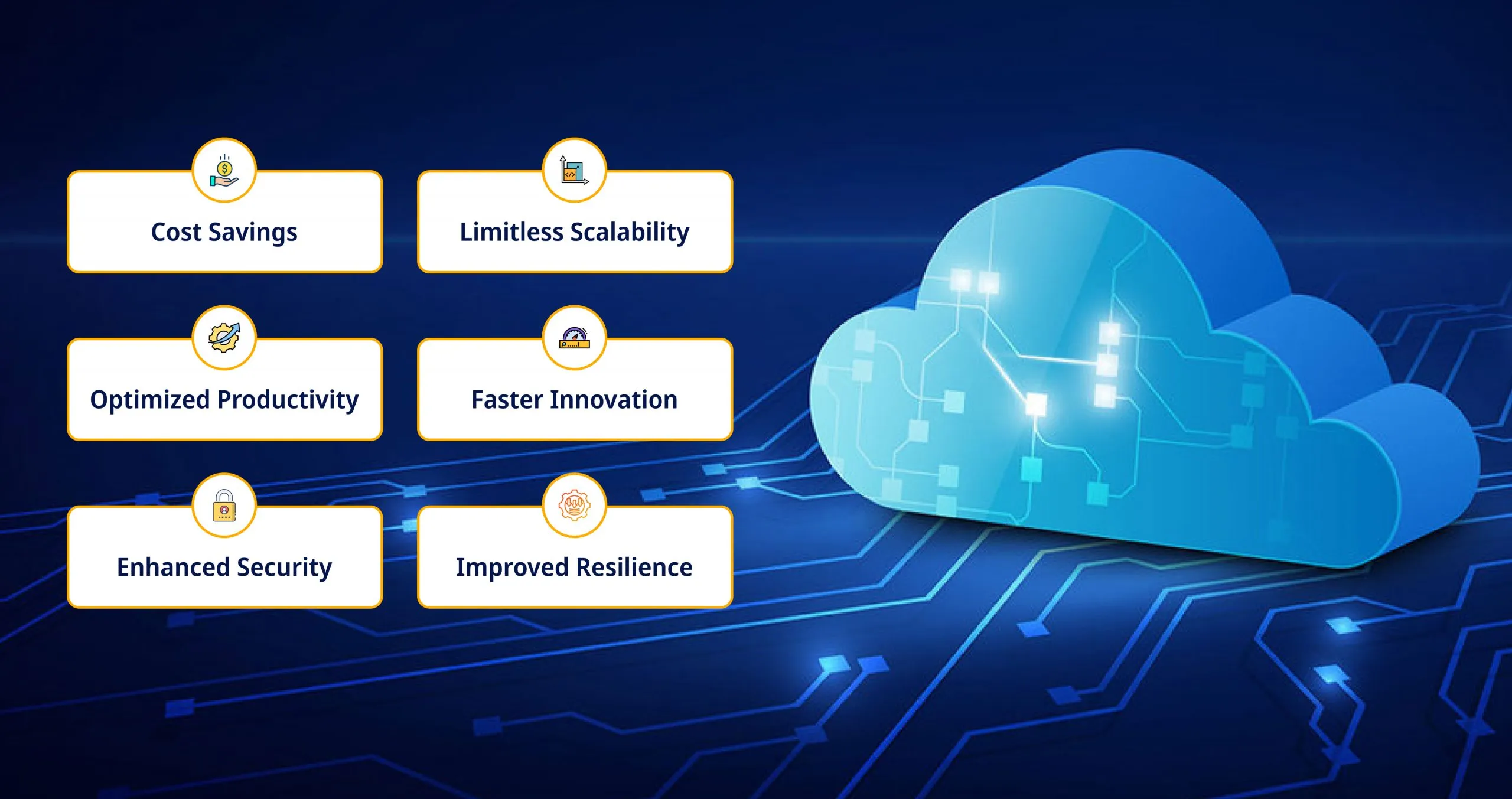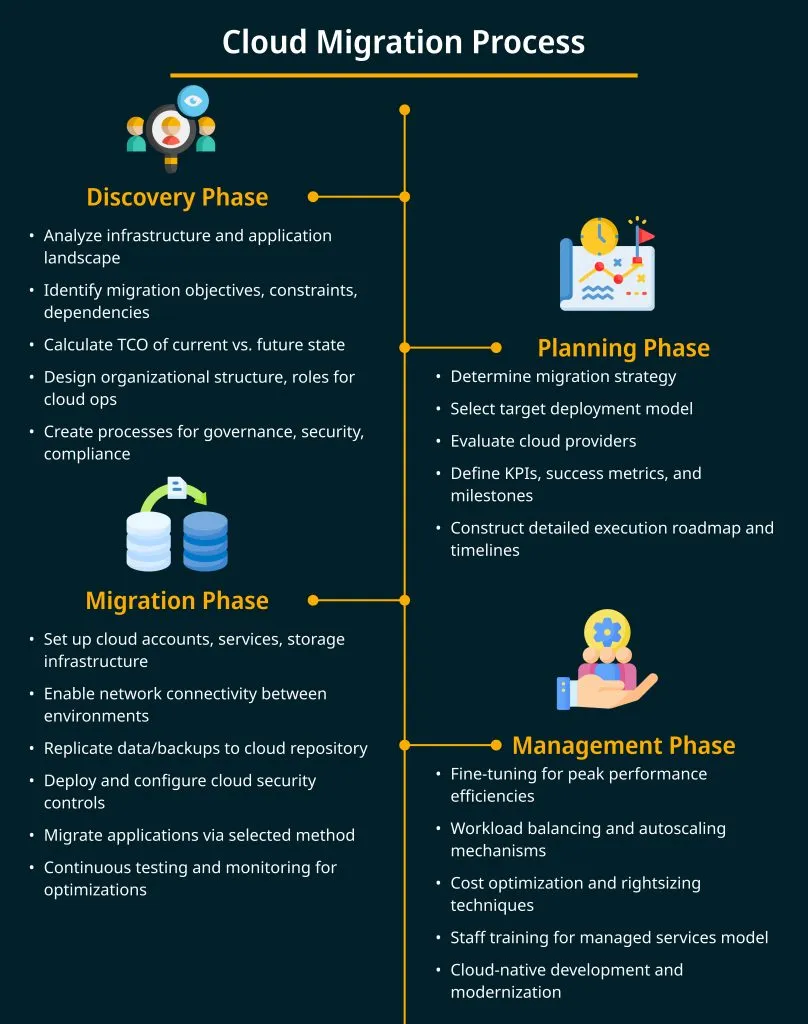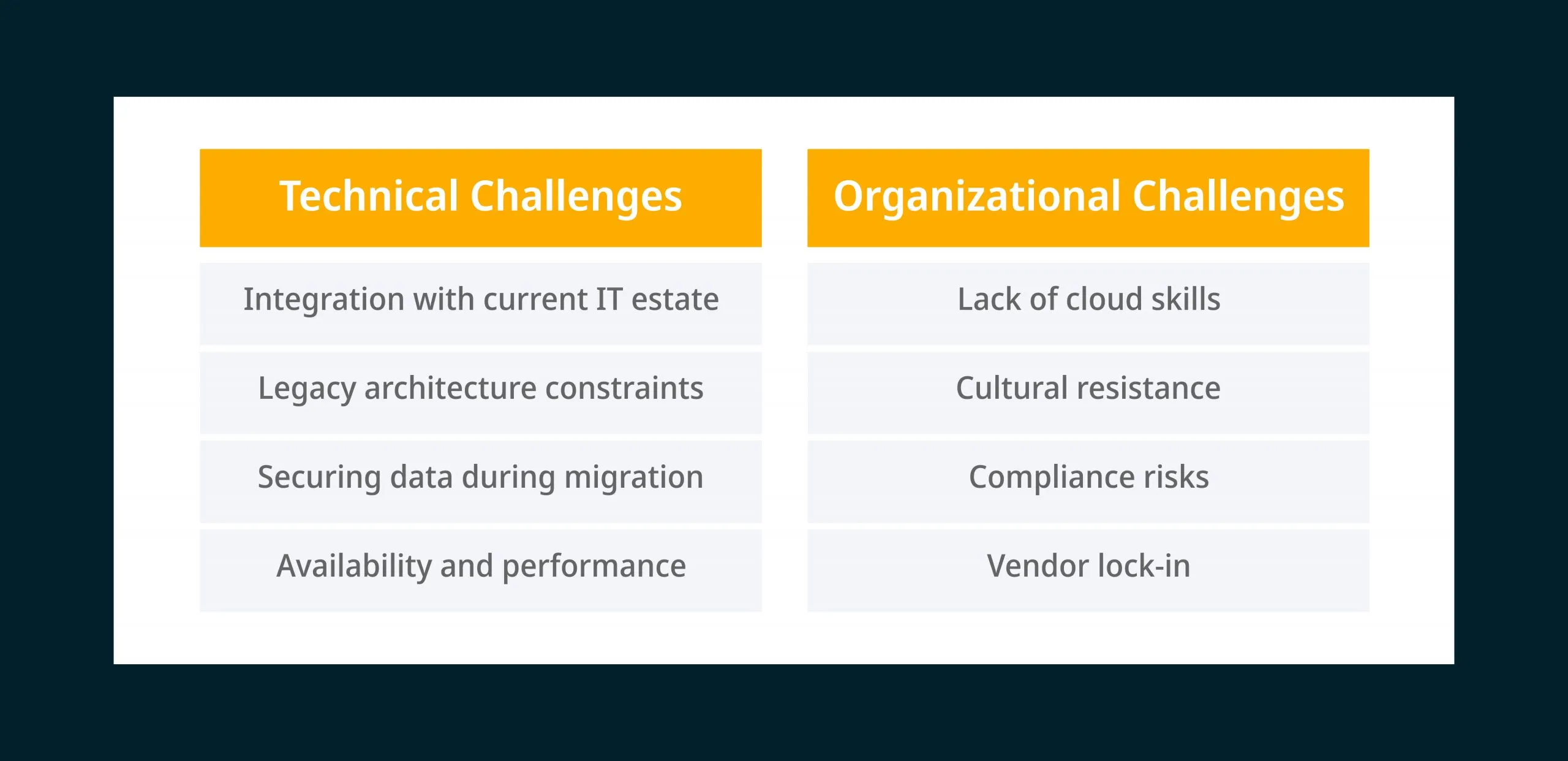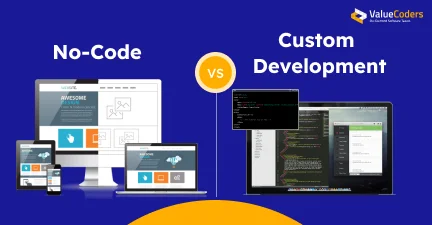Quick Overview
As business infrastructures struggle to meet evolving demands, cloud migration offers transformative solutions for efficiency, innovation, and growth.
This blog guides you through the compelling cloud migration benefits, necessary steps, optimal approaches, and potential obstacles to transitioning to the cloud. With proven strategies to ensure a smooth and successful migration, learn how cloud adoption can enhance your business operations.
Amidst the continuous surge of technological advancements, a recent study has uncovered a noteworthy trend that 87% of enterprises have a multi-cloud strategy today.
Adopting cloud migration is a strategic move for businesses, as 60% of global workloads are predicted to migrate to the cloud by 2025.
Yet, very few companies have an efficient cloud migration strategy. Common concerns like potential disruptions, lack of expertise, and data security issues often create roadblocks to adoption. This is precisely why we created this guide!
Within these pixels lie proven frameworks to smooth your transition to the cloud. We’ll also explore the cloud migration benefits, optimal migration process, techniques to minimize downtime, and real-world success stories.
So, in this weblog, we have everything you need to learn for an intriguing migration to the cloud! You’ll have the confidence and expertise to migrate at your own pace by the end.
The Urgency for Cloud Migration
Cloud migration provides a way out if mounting IT costs, capacity limitations, and outdated technologies slow your growth. By 2025, over 80% of enterprise workloads will transition to the cloud, rendering cloud adoption non-negotiable.
The transformative impact of cloud computing services can no longer be ignored. Public cloud spending is projected to grow by 20% annually, underlining the urgency of cloud migration.
Cloud migration benefits fuel business growth through endless scalability, lower TCO, and rapid innovation capabilities. Companies modernize their IT sector to gain tremendous competitive advantages as cloud application development services gain steam.
Upgrade your business seamlessly with our expert guidance on cloud migration.
Legacy apps and data can be seamlessly migrated to the cloud without business disruptions. You remain fully in control of customizing and governing complete IT environments.
Rising cloud maturity assures robust security, availability, and compliance for highly regulated industries like BFSI and healthcare.
The inertia around cloud migration must be broken with purposeful urgency. With the proliferation of cloud computing services, businesses should tap this catalyst for efficiency, resilience, and growth!
Exploring the Benefits of Cloud Migration
The cloud promises favorable benefits that no business can afford to ignore. Deciphering the tangible gains from adopting the cloud remains unclear for many organizations.
Let’s clear this our and get into the multidimensional advantages of cloud adoption:
1. Cost Savings: Migrating to the public cloud slashes IT infrastructure and operations costs by over 30%. Without bulky upfront capital investments, you only pay for used cloud computing services based on consumption. Lower licensing, hardware, and management costs coupled with server consolidation catalyze these savings.
2. Limitless Scalability: The cloud eliminates capacity constraints by offering instant access to server resources as your needs inflate. This on-demand scalability eradicates the risk of turning customers away due to limited infrastructure. You can scale storage, network capabilities, and computing power to accommodate growth in real time.
3. Optimized Productivity: Cloud collaboration tools like G Suite greatly enhance workforce productivity. Employees get cloud migration benefits and secure access to data from anywhere, work in tandem on projects, and streamline cumbersome workflows. Distributed teams collaborate better to boost innovation velocity.
4. Faster Innovation: Cloud migration paves the way for rapid experimentation and deployment of new capabilities. Organizations gain competitive advantages of cloud transition by reducing time-to-market for rolling out new features, offerings, or apps by over 70%.
5. Enhanced Security: Leading cloud providers implement rigorous security controls that surpass on-premise legacy systems. Cloud data remains protected around the clock with advanced threat protection, encryption, and access controls.
6. Improved Resilience: Cloud leverages distributed infrastructure for 99.99% uptime and rapid disaster recovery – difficult and expensive to achieve otherwise! You minimize the risk of data losses and downtime.
Still doubting if the cloud migration benefits are worthwhile?
Our clients vouch for the transformative impact of cloud adoption on revenues, costs, security, and customer success.
Also Read: Cloud Computing In Manufacturing: Solutions To Stay On Top
Streamlining the Cloud Migration Process
Migrating to the cloud can seem intimidating without clarity on the step-by-step process. However, with meticulous planning and robust execution, the cloud deployment process can be smooth and disruption-free.
Let’s run through the cloud migration playbook covering all key phases:
Cloud Migration Process
#1. Discovery Phase
- Analyze infrastructure and application landscape: Assess your current IT infrastructure thoroughly, including servers, storage, network equipment, databases, applications, etc. In complex environments, data lake consulting can help structure raw and fragmented data into a centralized, queryable format even before migration begins. This allows creating an inventory of all assets to be migrated.
- Identify migration objectives, constraints, dependencies: Determine business goals from migration like improved efficiency, faster delivery, etc. Identify technical and business constraints impacting migration, like budget, timelines, resource skills, etc. Also, document interdependencies between systems.
- Calculate TCO of current vs. future state: Compare the total cost of ownership models between retaining existing infrastructure vs migrating to the cloud. This includes capital, operational, and labor costs. It helps determine ROI.
- Design organizational structure, roles for cloud ops: Reorient IT team structure, roles, and responsibilities to suit the cloud operating model, vastly different from on-premise.
- Create processes for governance, security, compliance: Define policies spanning access control, resource allocation, data retention, etc., while adhering to industry regulations.
#2: Planning Phase
- Determine migration strategy: Rehost, Replatform, Refactor: Assess whether to simply lift and shift systems to the cloud (rehosting) vs. modifying architectures (replatforming) vs. deep refactoring of applications based on business goals, timelines, and costs.
- Select target deployment model: public, private, hybrid cloud: Choose the right cloud model based on application architectures, security requirements, and availability needs.
- Evaluate cloud providers based on technology stack fit: Analyze cloud migration benefits and services offered by top cloud services companies AWS, Azure, GCP, etc., to pick the ideal platform based on compatibility with the existing tech stack.
- Define KPIs, success metrics, and milestones: Determine quantitative success metrics spanning performance, efficiencies, release cycles, etc. Useful for measuring ROI. Also, define delivery timelines.
- Construct detailed execution roadmap and timelines: Create an exhaustive cloud adoption plan covering phases, activities, dependencies, owner details, tools, etc., required for smooth migrations.
#3: Migration Phase
- Set up cloud accounts, services, storage infrastructure: Provision cloud provider accounts, create virtual networks, and set up storage repositories like S3 buckets, data lakes, etc., based on application requirements.
- Enable network connectivity between environments: Establish secure VPN tunnels between current infrastructure and cloud platform to facilitate real-time data flow during migration.
- Replicate data/backups to cloud repository: Gradually transfer application data, databases, and other storage systems to the cloud environment. This can be scheduled during maintenance windows.
- Deploy and configure cloud security controls: Install identity and access management, encryption, malware protection, and auditing tools offered by cloud providers to ensure a robust security posture.
- Migrate applications via selected method: Based on whether the rehosting, replatforming, or refactoring approach was chosen, existing applications are ported to the cloud environment.
- Continuous testing and monitoring for optimizations: Rigorously test migrated applications for performance, security, and functionality. Monitor for glitches and optimize configurations continuously.
Unleash operational efficiency with our expertise in seamless cloud migration.
#4: Management Phase
- Fine-tuning for peak performance efficiencies: Continually tweak and tune resource allocation, data partitioning, caching layers, etc., to optimize workload performance on cloud infrastructure.
- Workload balancing and autoscaling mechanisms: Configure automated mechanisms to distribute application traffic across cloud servers and expand/shrink resources based on demand fluctuations.
- Cost optimization and rightsizing techniques: Analyze usage trends using cloud cost management tools for cloud migration best practices. Continually right-size cloud resource inventory to save costs.
- Staff training for managed services model: Reskill IT admins on new capabilities like infrastructure-as-code, CI/CD pipelines, microservices, etc., to manage cloud-centric environments efficiently.
- Cloud-native development and modernization: Progressively refactor legacy applications by embracing cloud-native architectures using containers, serverless models, etc., to maximize ROI.
Organizations can seamlessly navigate cloud migration with meticulous planning, fail-safe automation, and expert managed services. Our reference architecture allows you to migrate legacy systems faster and optimize workloads on the cloud.
Understanding Different Types of Cloud Migration
With multiple approaches to porting applications to the cloud, determining the ideal migration strategy is critical yet confusing.
Should you directly lift-and-shift systems or rebuild them cloud-native? The common types of cloud migration include the following:
1. Rehosting (Lift-and-Shift Migration)
This is the simplest and fastest way to migrate applications to the cloud. It involves lifting the entire application from on-premise infrastructure and shifting it to infrastructure-as-a-service (IaaS) on the public cloud.
- Applications are migrated as-is without any changes
- Entire technology stack moves to cloud IaaS, including app code, databases, runtimes, etc.
- Cloud virtual machines replicate existing environment
- Substantial cost savings from shutting down data centers
- Quick time-to-market taking only weeks
- Suited for time/budget constrained migrations
2. Replatforming (Partial Refactoring)
Here, applications are selectively modernized to optimize them for cloud-scale efficiencies. The core code base is untouched, but cloud managed services are integrated.
- Incorporates cloud DBaaS, messaging, and caches to improve performance
- Adds management and monitoring capabilities via cloud-native tools
- Enables flexibility by decoupling app modules and data layers
- Improves reliability, availabilities of apps on cloud
- Fine-tunes spending by picking managed services mix
- Needs code changes so takes more effort than rehosting
3. Repurchasing (Full Refactoring)
This approach fully re-architects applications specifically for cloud delivery with cloud-native attributes.
- App is rebuilt from the ground up using microservices and serverless models
- Cloud capabilities deeply embedded in application logic
- Demands extensive code changes and testing
- Highest effort and costs but catalyzes innovation
- Delivers long-term agility, scalability, and cost benefits
- Works best for new functionality rather than migration
Choosing between Multi-Cloud vs Single-Cloud is also pivotal. While single cloud streamlines efforts, multi-cloud fuels cost arbitrage and prevents vendor lock-in.
With due diligence into time, cost, and capabilities constraints, organizations can derive the optimal cloud migration strategy personalized to their environments, priorities, and appetite.
Also Read: Multi-Cloud Vs. Single-Cloud Strategies: Which Is Right For Your Business?
Confronting Challenges Head-On
Despite the numerous advantages of cloud migration, enterprises encounter valid technology and business challenges when migrating their business systems to the cloud.
Technical Challenges
- Integration with current IT estate: Migrating specific workloads to the cloud while retaining interdependent systems on-premise demands robust integration of the two environments. Solutions include transitional hybrid cloud adoption and unified identity management.
- Legacy architecture constraints: Monolithic apps with tightly coupled modules can impede migration of Agile processes, and decoupled microservices architecture allows easier cloud transitions.
- Securing data during migration: Data security risks are heightened temporarily during migration. Encryption, access restrictions, and VPN tunnels mitigate confidential data leaks.
- Availability and performance: Meticulous load testing, failover clustering, and staged rollouts avoid downtime as systems shift to the cloud. Auto-scaling, CDNs, and caching ensure optimal performance.
Organizational Challenges
- Lack of cloud skills: Reskilling programs, external consulting, and managed services can overcome talent gaps during adoption. Developing internal capabilities is crucial long term.
- Cultural resistance: Clear communication of cloud benefits to end-users and executives secures buy-in. Change management processes ease anxiety over modifications.
- Compliance risks: Consulting regional legal and regulatory experts to protect against violations. Geo-fencing data storage, and access controls achieve compliance.
- Vendor lock-in: Using multiple cloud providers ensures greater flexibility and interoperability.
However, practical cloud migration strategies and best practices help conquer these barriers. Robust network integration preserves access across AWS vs Azure vs Google Cloud.
Meticulous testing and expert managed services ensure smooth transitions without productivity lags.
Overcome hurdles with our strategic approach to cloud migration, ensuring a smooth and secure transition.
With cogent TCO analysis and retraining programs addressing skill gaps, organizations can align stakeholders on cloud ROI. Hybrid models also allow for balancing legacy and cloud-native environments.
While the barriers seem intimidating initially, seasoned partners expedite simplified cloud adoption.
At ValueCoders, our solution architects integrate your specific constraints into personalized blueprints, ensuring that the tailored approach catalyzes the transformation for optimal cloud migration benefits. Let’s look at them:
Data Security
- Enable endpoint and network security tools provided by cloud providers such as encryption, firewalls, IAM
- Validate security posture through frequent audits and penetration testing
- Establish data classification policies and residence restrictions
- Back up critical data and systems before initiating migration
Legacy Application Compatibility
- Containerize monolithic apps to aid cloud deployment
- Partially refactor apps by exposing APIs for integration
- Utilize virtualization to replicate the on-premise environment
- Leverage cloud managed services to optimize performance
Organizational Resistance
- Involve stakeholders early through focus group discussions
- Provide training on new tools and processes for a smooth transition
- Highlight how the cloud enables employee efficiency and innovation
- Celebrate early quick wins and milestones through migration
Business Continuity
- Build redundancy mechanisms for failover and high availability
- Provision additional cloud capacity to handle usage spikes
- Implement mature disaster recovery mechanisms
- Test and fine-tune BC procedures regularly post-migration
Businesses can mitigate risks to maximize cloud migration benefits with robust cloud migration strategies in 2024. Our application migration methodology and managed services smooth your cloud transition journey.
Real-world Insights
Despite the great promise of cloud migration concepts, practical, real-world examples build confidence like no other.
Let’s explore some inspirational case studies of pioneering enterprises that successfully transformed via the cloud:
1. Global Bank’s Mortgage Application Transformation
Challenges: This large bank had complex, outdated on-premise mortgage systems, impeding agility and customer experience. Lengthy release cycles prevented responding quickly to market demands.
Migration Strategy: They opted for Amazon AWS cloud computing services as the primary cloud provider and adopted a replatforming approach to modernizing systems. This involved maintaining core systems while rebuilding newer modules as cloud-native, decoupled microservices.
Outcomes
- 40% quicker release cycles accelerating new feature rollout
- 300% increase in mortgage application volume
- 60% improvement in customer satisfaction scores
- More accurate risk analysis models through cloud data analytics
2. Healthcare Provider’s Data Consolidation Initiative
Challenges: A major healthcare provider managed clinical and patient data across heterogeneous systems. Data complexity was increasingly unwieldy while compliance demands grew.
Migration Approach: Data from multiple sources can be consolidated into a single cloud data lake using Azure cloud computing in healthcare. Infrastructure-as-code automated security controls, access policies, and data lifecycle management.
Benefits:
- Automated data pipelines improved analytics and AI use cases
- Unified data access accelerated research and diagnosis
- Granular access controls enhanced regulatory compliance
- 60% increase in clinician productivity from process automation
Intrigued by such possibilities but overwhelmed by attempting transformation alone?
Our proven cloud consultants equip you with time-tested cloud migration benefits tailored to your unique constraints across industries and domains. Partner with specialists and let your cloud migration dreams take flight!
Elevate your business to new heights with our expert guidance.
Conclusion
Change is here, bringing a new era of digital transformation powered by the cloud. We uncovered the manifold technical and business potential catalyzed by prudent cloud adoption – from spurring innovation to controlling costs.
✅ A step-by-step migration playbook
✅ Strategies to confront potential barriers
✅ Real-world success stories for inspiration
Cloud migration benefits become apparent only when established on sturdy foundations. Let ValueCoders fast-track your transformation with proven blueprints personalized to your environment.
Our developers and engineers seamlessly transition applications at scale while boosting ROI. Partner with the experts and glimpse operational excellence!
The future beckons – let’s migrate to the cloud fearlessly together!












